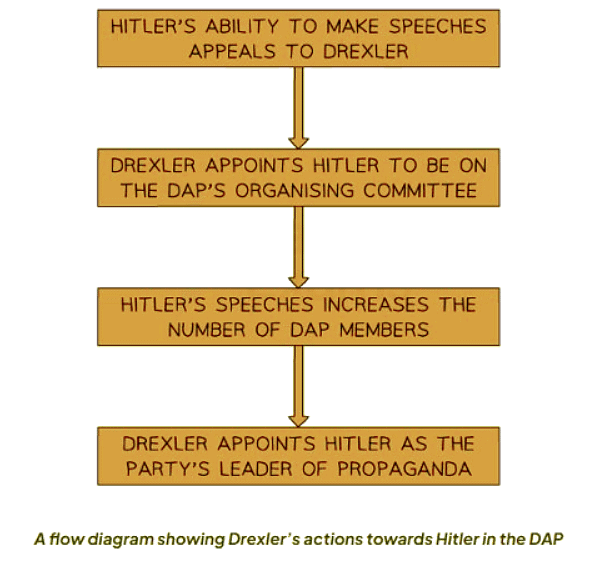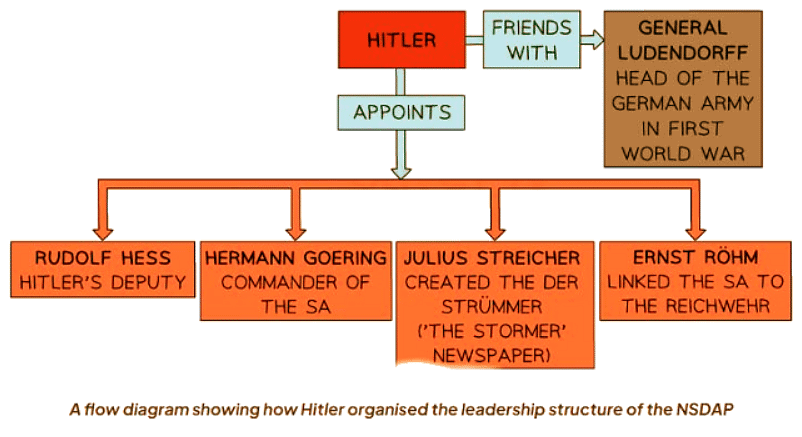Year 11 Exam > Year 11 Notes > History for GCSE/IGCSE > What Did the Nazi Party Stand For in the 1920s?
What Did the Nazi Party Stand For in the 1920s? | History for GCSE/IGCSE - Year 11 PDF Download
How Involved was Hitler in the Creation of the Nazi Party? - Timeline & Summary

- Adolf Hitler served as a messenger during the First World War, tasked with delivering messages between regiments. This dangerous role earned him two medals for bravery. In October 1918, Hitler was injured in a mustard gas attack, temporarily blinding him and requiring hospital treatment. It was in the hospital that he learned about the armistice and Germany's defeat, leading him, like many other soldiers, to believe that Weimar politicians had committed a ‘dolchstoss’ by agreeing to the Treaty of Versailles.
- The abdication of the Kaiser in November 1918 resulted in the formation of many new political parties. Concerned about the threat these parties posed to public safety, the Weimar Republic employed Hitler as part of their intelligence operation. His task was to attend a meeting of a new political party and report back on its potential danger. This is when Hitler discovered the DAP - the German Workers’ Party.
- Over the next two years, Hitler's involvement with the DAP increased, eventually leading him to become its leader. His oratory skills and political vision attracted more members, prompting him to rebrand the party as the NSDAP, or the Nazi Party.
The Development of the DAP
- Anton Drexler, a railway mechanic from Munich, founded the DAP in February 1919.
- By September 1919, the DAP had 23 members.
- The DAP was a right-wing party aimed at attracting the working classes.
- The government hired Hitler to spy on political parties in Munich.
- The Weimar Republic struggled to survive threats from extremist parties.
- As an ex-soldier, Hitler desperately needed the job.
- Most of Germany’s armed forces had been unemployed after the Treaty of Versailles limited the German army to 100,000 soldiers.
- Hitler attended his first DAP meeting on 12th September 1919.
- The ideas discussed at the meeting resonated with Hitler’s personal beliefs.
- On 19th September 1919, Hitler joined the DAP, going against his government assignment.
Changing the DAP to the NSDAP
- By 1920, the DAP had transformed into the National Socialist German Workers’ Party (NSDAP or Nazi Party).
- Hitler solidified his control over the NSDAP by 1921 through various strategies:
- Altering the party's principles to the Twenty-Five Point Programme.
- Showcasing Hitler's charismatic appeal.
- Enhancing the party's organizational framework.
- Enforcing a change in leadership and appointing key members.
- Establishing the NSDAP's private army, the SA (Sturmabteilung).

The Twenty-Five Point Programme
- When Adolf Hitler took charge of the German Workers' Party's (DAP) propaganda, he recognized the necessity for a formal statement of the party's policies.
- The DAP had already touched upon crucial issues:
- Removal of Weimar politicians who had endorsed the Treaty of Versailles.
- Revision of the Weimar Constitution to impose more restrictions on democratic processes.
- Attributing Germany's problems solely to the Jewish population.
- In January 1920, Hitler and Anton Drexler penned the Twenty-Five Point Programme, which outlined the DAP's objectives.

The Appeal of Hitler
- The German Workers' Party (DAP) witnessed a rapid surge in its membership during 1920.
- By June 1920, the DAP's member count stood at 1,000 individuals.
- By the close of the same year, membership soared to 3,000.
- Hitler's charismatic appeal was the primary driver behind this unprecedented rise in membership.
- Hitler dedicated significant time to honing his oratory skills by practicing his speeches diligently.
- He crafted a distinctive oratory style characterized by escalating speech tempo leading to a fervent and forceful climax, rendering his arguments highly compelling.
- To enhance the impact of his speeches, he meticulously rehearsed specific hand gestures, even capturing images of his practice sessions for reference.
- Serving as the propaganda minister, Hitler strategically utilized images and posters of himself delivering speeches to bolster his public image.
- Within his first year of DAP membership, Hitler delivered a total of 31 speeches, solidifying his presence within the party.
Question for What Did the Nazi Party Stand For in the 1920s?Try yourself: What was the role of Adolf Hitler in the creation of the Nazi Party?View Solution
Nazi Party: Organisation and Leadership
- Hitler utilized his influence over Drexler to bring about significant changes in the party's structure.
- By January 1920, the German Workers' Party (DAP) established a central office in Munich. Rudolf Schüssler, a close associate of Hitler, assumed control of the party's administration, leading to improved meeting organization and increased financial resources.
- The party underwent a name change on Hitler's proposal, becoming the National Socialist German Workers' Party (NSDAP), symbolizing both nationalist and socialist ideologies. This rebranding aimed to attract a broader audience.
- To set itself apart, the NSDAP adopted the swastika and a straight-armed salute. The swastika, originating from Asia, was used to symbolize prosperity, while the salute was inspired by Ancient Rome.
- In December 1920, the NSDAP launched a newspaper called Völkischer Beobachter (the 'People's Observer'). Within a year, the party was distributing 17,000 copies of the newspaper, expanding its influence beyond Munich.
- Hitler's increasing popularity led to a leadership contest in July 1921, resulting in his victory over Drexler. He then implemented significant changes within the NSDAP's inner circle to solidify his leadership position.
The Structure of the NSDAP

What was the SA?
- The Sturmabteilung, also known as the 'Stormtroopers' or 'SA', served as the NSDAP's private army.
- Due to the prevalent political violence in Weimar Germany, many political factions resorted to forming paramilitary units.
- Established in August 1921, the SA earned the moniker 'Brownshirts' owing to the color of their uniforms.
- Hitler recruited individuals such as the unemployed, students, and ex-soldiers into the SA, leveraging their discontent.
- These groups, dissatisfied with the Weimar government, were enticed by promises of financial support and a sense of routine.
- Utilizing the SA, Hitler aimed to manage crowds during gatherings, instigate street altercations, disrupt rival group meetings like the KPD, and bolster the NSDAP's image.
- By 1922, the Brownshirt count reached 800, steadily escalating in numbers.
- In 1923, Ernst Röhm assumed leadership of the SA, operating somewhat independently from Hitler's direct authority.
- Recognizing Röhm's popularity among the stormtroopers, Hitler established the 'Shock Troop' or 'Stosstrupp'—a select group designated as his personal guards.
The Impact of Hitler on the NSDAP
- In January 1922, Hitler convened a party conference where he asserted his autocratic control over the NSDAP.
- During this conference, he spoke for two and a half hours.
- He convinced NSDAP members to relinquish their right to elect the party leader.
- This move effectively turned the NSDAP into a dictatorship.
- The NSDAP's popularity surged in 1923.
- By November 1923, the NSDAP had grown to 50,000 members.
- Amid the hyperinflation crisis, many Germans began to seek solutions from extremist parties like the NSDAP.
The document What Did the Nazi Party Stand For in the 1920s? | History for GCSE/IGCSE - Year 11 is a part of the Year 11 Course History for GCSE/IGCSE.
All you need of Year 11 at this link: Year 11
|
81 videos|86 docs|18 tests
|
FAQs on What Did the Nazi Party Stand For in the 1920s? - History for GCSE/IGCSE - Year 11
| 1. How involved was Hitler in the creation of the Nazi Party? |  |
Ans. Hitler was heavily involved in the creation of the Nazi Party. He joined the German Workers' Party (DAP) in 1919 and quickly rose to prominence within the party, eventually becoming its leader and changing its name to the National Socialist German Workers' Party (NSDAP) in 1920.
| 2. What was the significance of the Twenty-Five Point Programme in the development of the Nazi Party? |  |
Ans. The Twenty-Five Point Programme was a key document outlining the Nazi Party's ideology and goals, including nationalist and anti-Semitic views. It helped to attract supporters and shape the party's direction in the early 1920s.
| 3. How did Hitler's appeal contribute to the growth of the Nazi Party in the 1920s? |  |
Ans. Hitler's charisma, oratory skills, and nationalist rhetoric helped to attract a large following for the Nazi Party in the 1920s. His ability to connect with disillusioned Germans and offer them a sense of hope and purpose played a significant role in the party's growth.
| 4. What was the organizational structure of the Nazi Party under Hitler's leadership? |  |
Ans. Under Hitler's leadership, the Nazi Party had a hierarchical organizational structure with Hitler at the top as the Führer. There were various levels of leadership, from local party branches to regional and national leadership positions, all of which were tightly controlled by Hitler and his inner circle.
| 5. What did the Nazi Party stand for in the 1920s, and how did its ideology evolve over time? |  |
Ans. In the 1920s, the Nazi Party stood for nationalism, anti-Semitism, anti-capitalism, and anti-communism. Over time, the party's ideology became increasingly radical and focused on creating a totalitarian state, promoting Aryan supremacy, and expanding German territory through militaristic means.

|
Explore Courses for Year 11 exam
|

|
Signup for Free!
Signup to see your scores go up within 7 days! Learn & Practice with 1000+ FREE Notes, Videos & Tests.
Related Searches
















